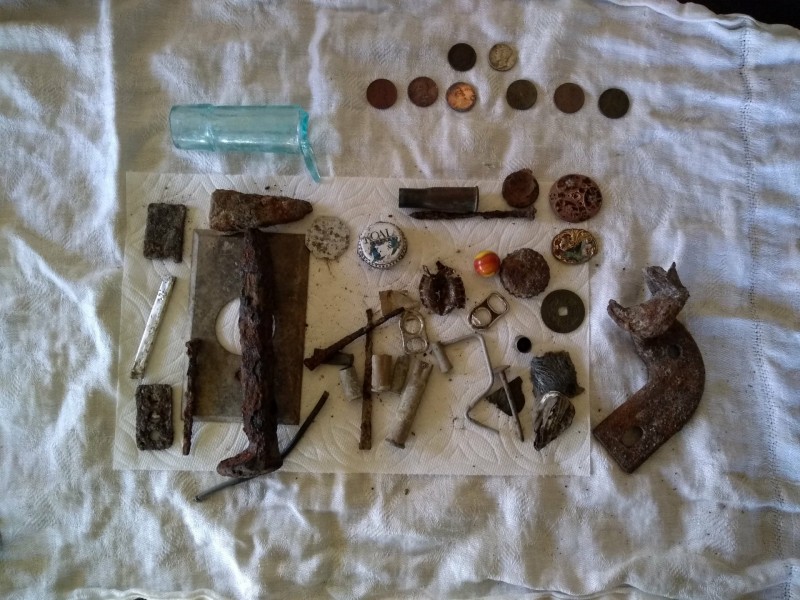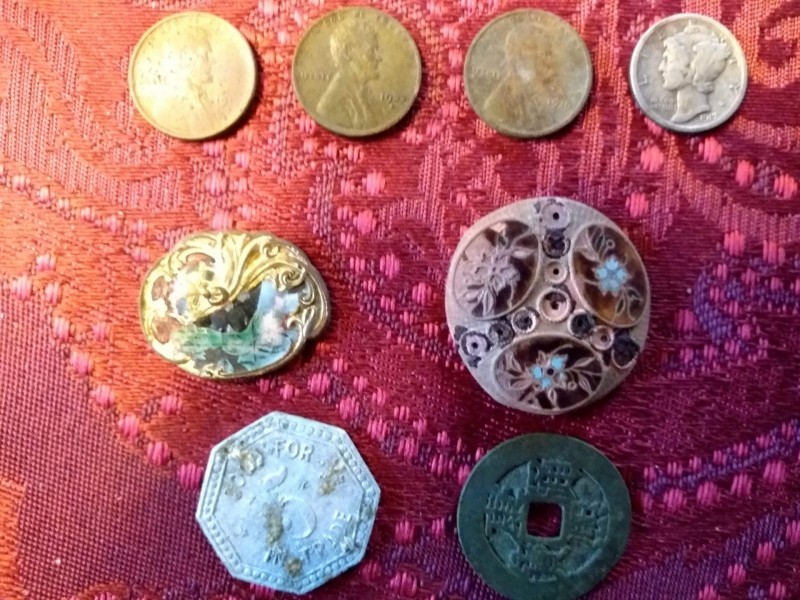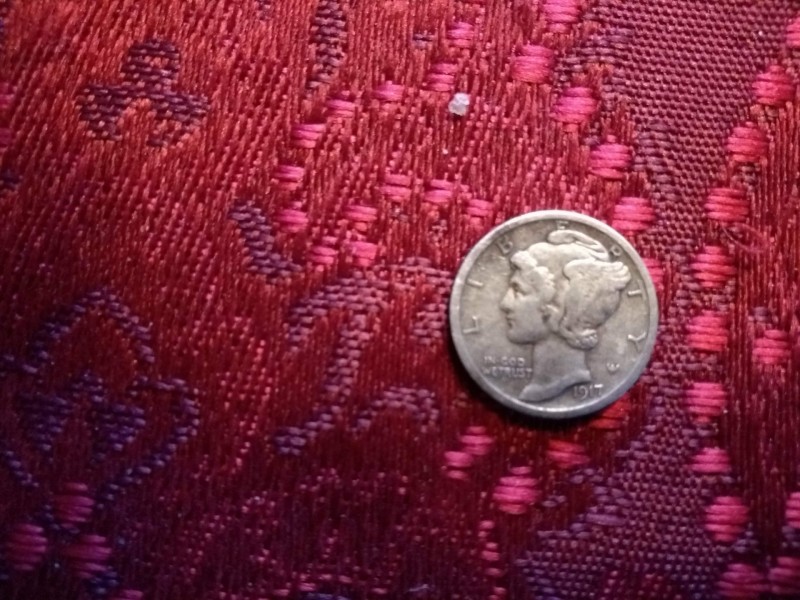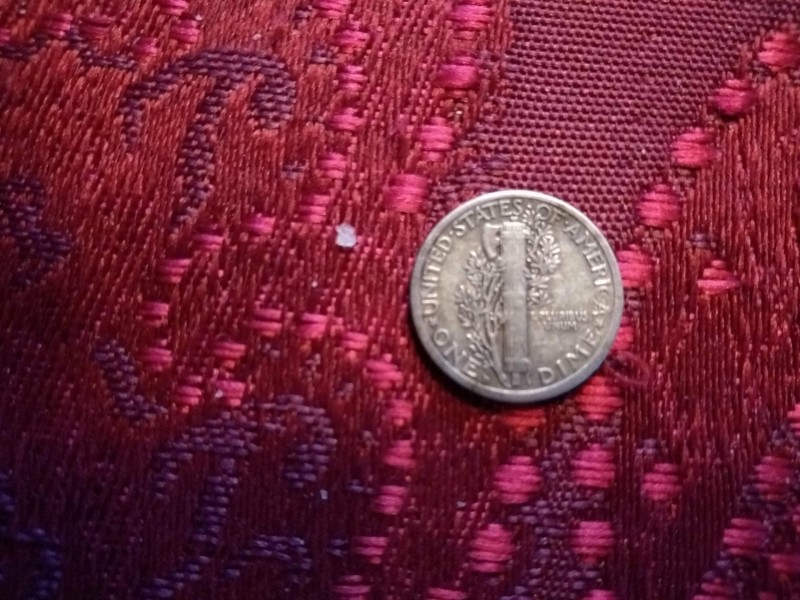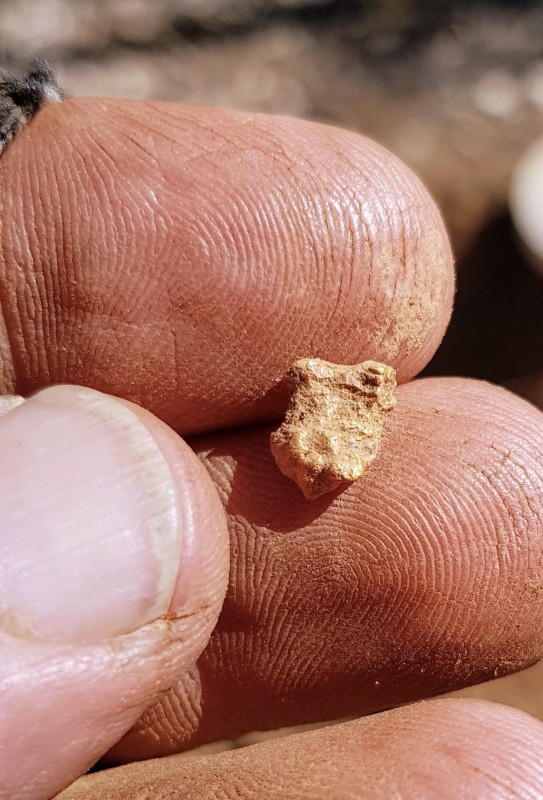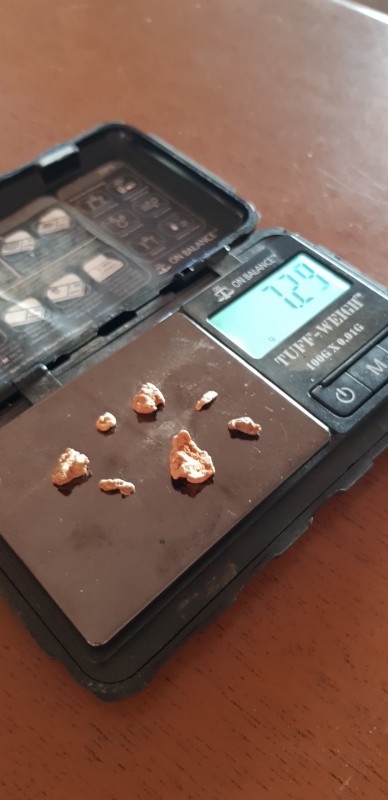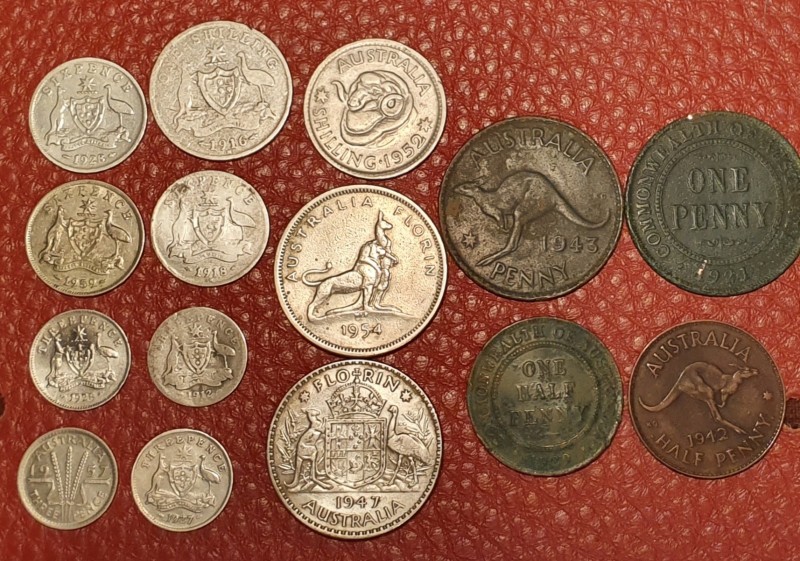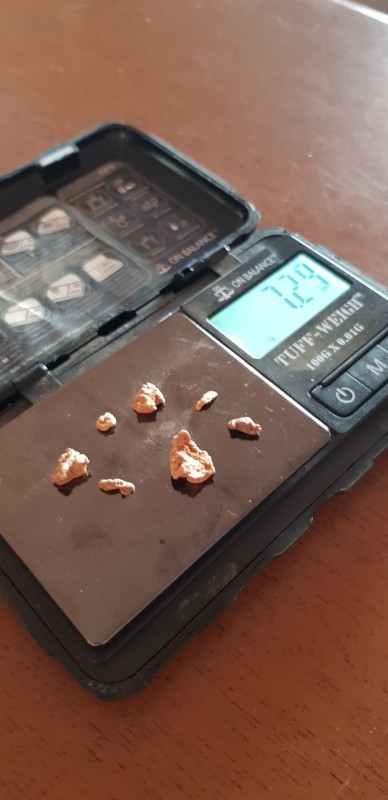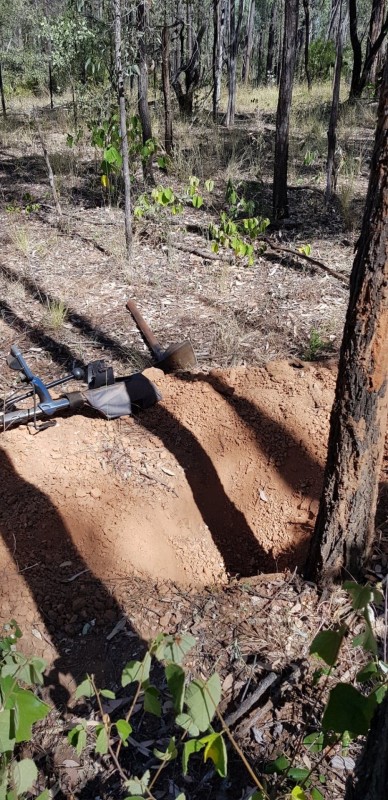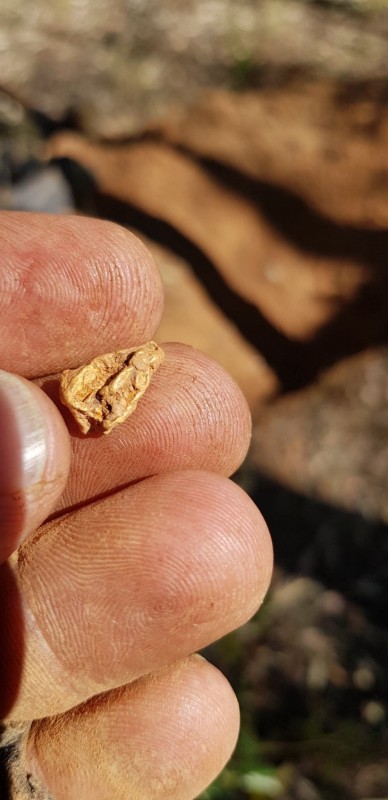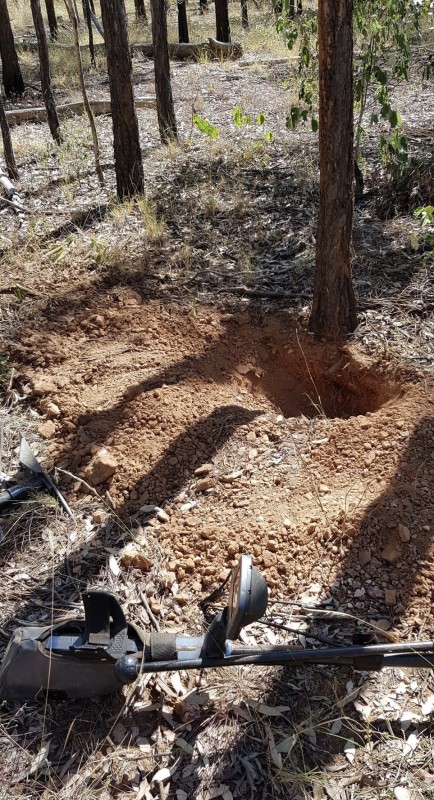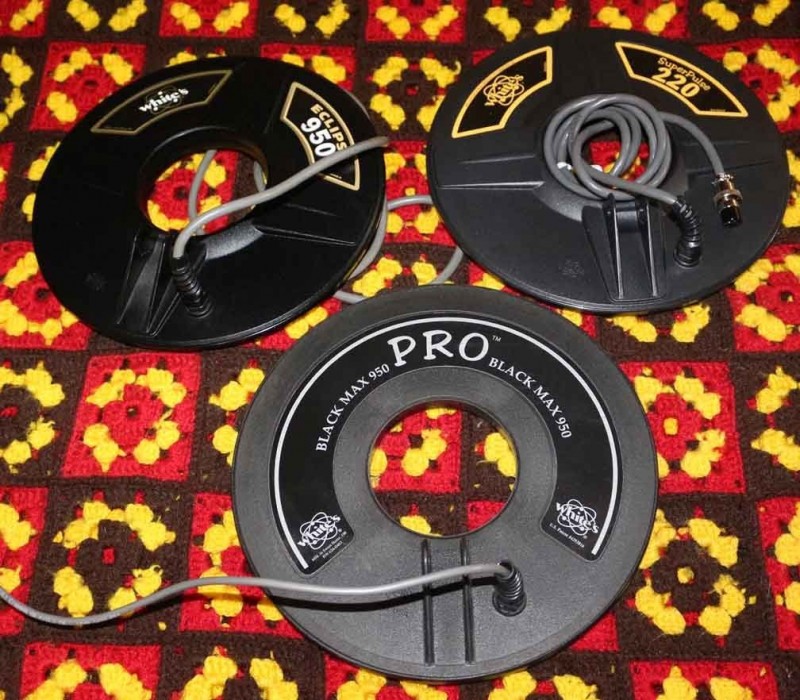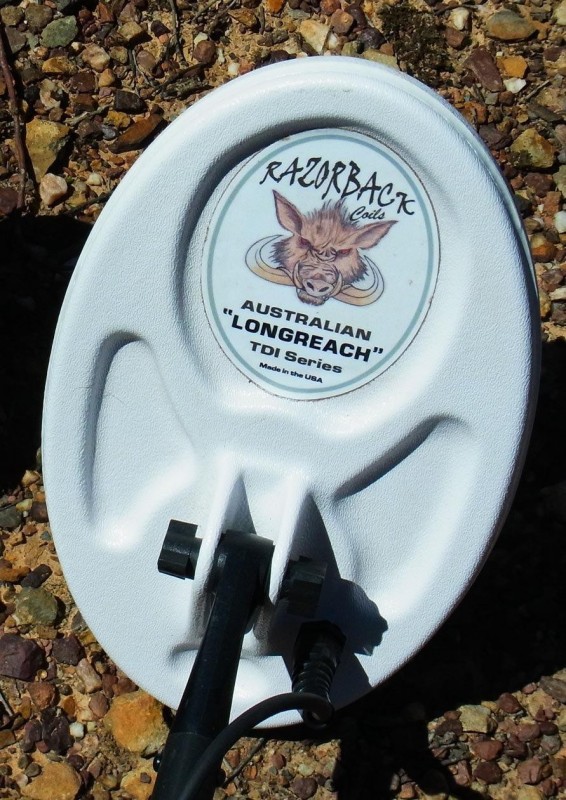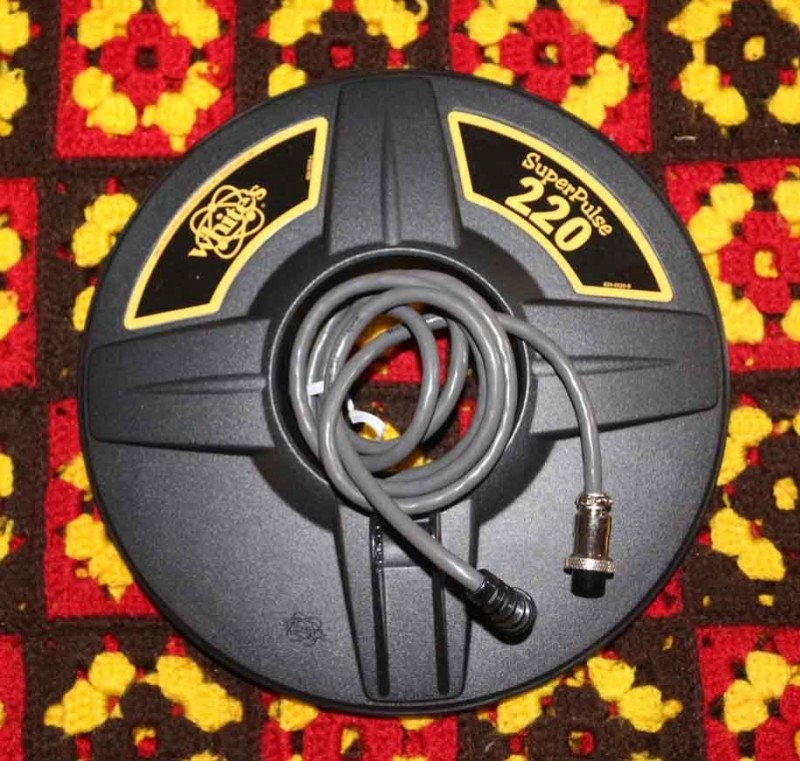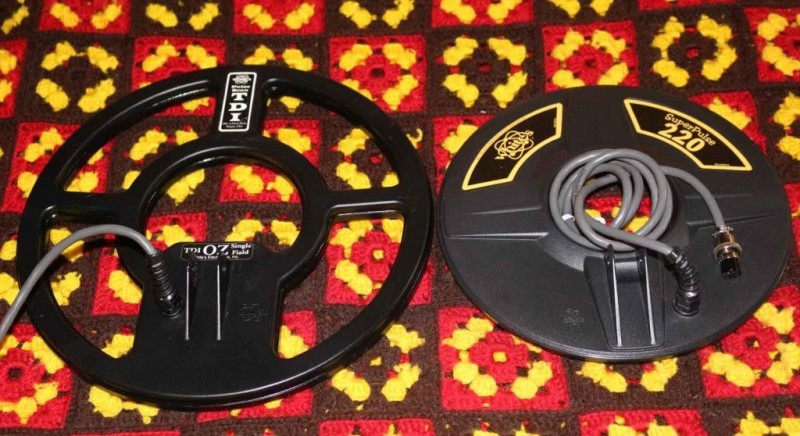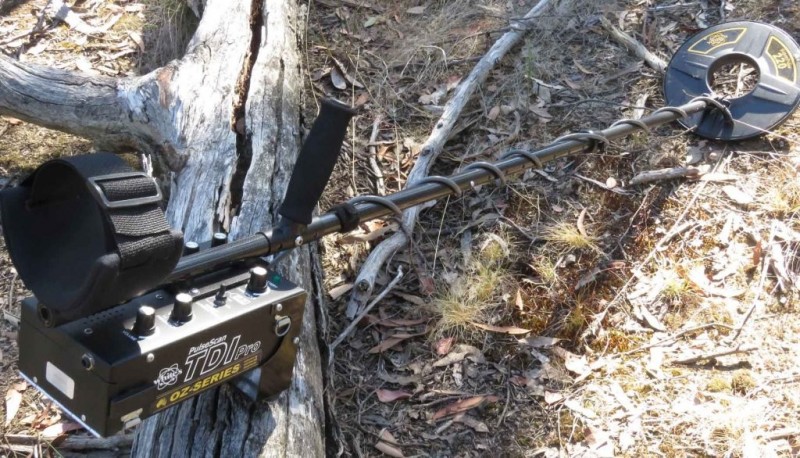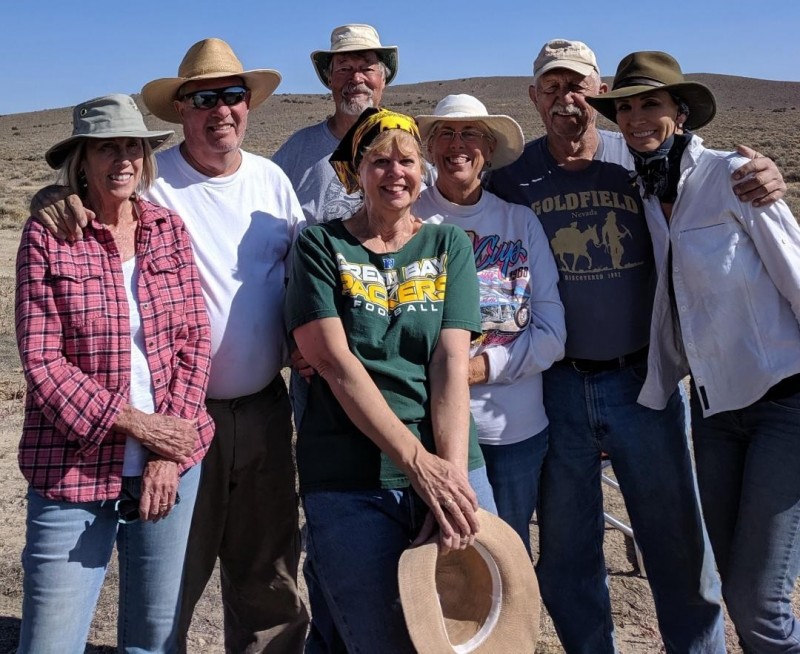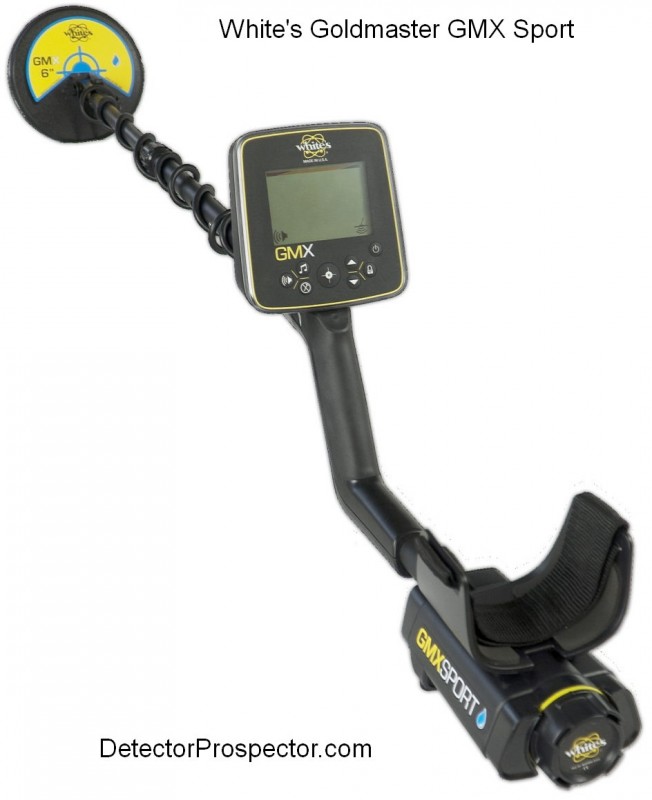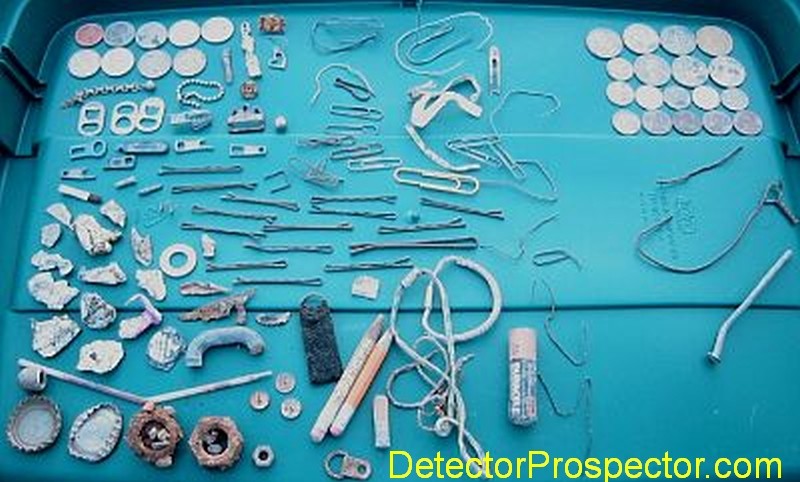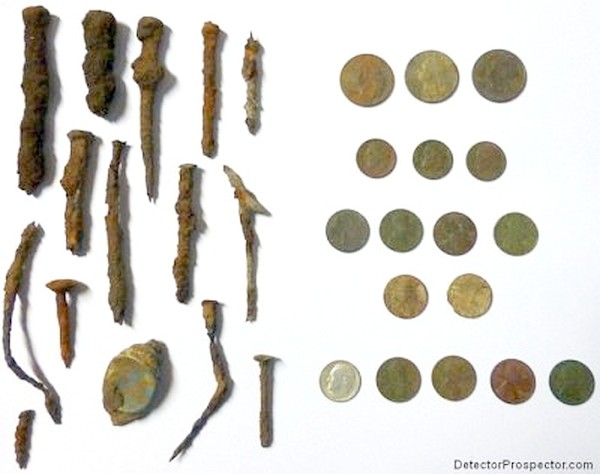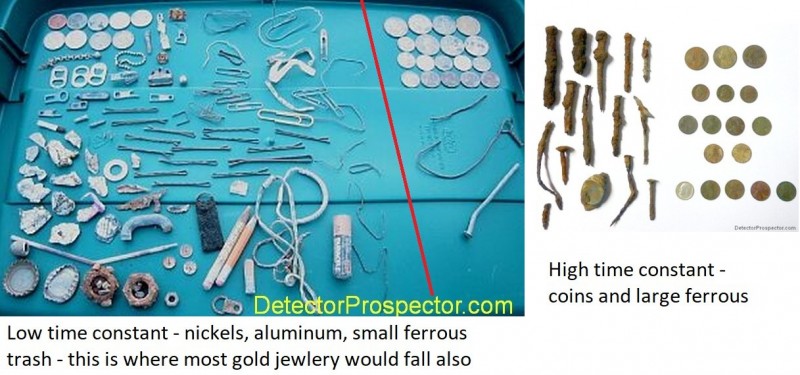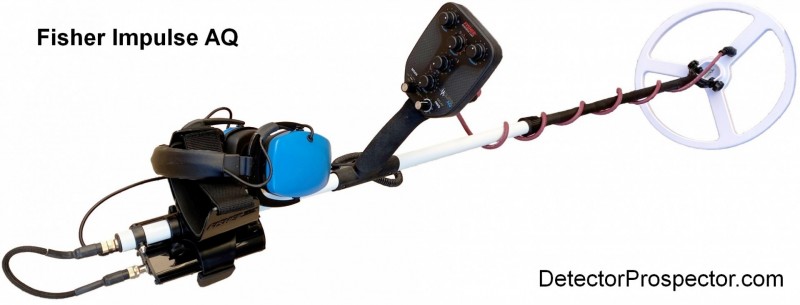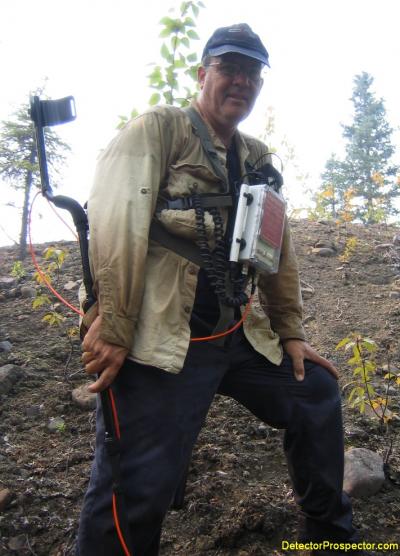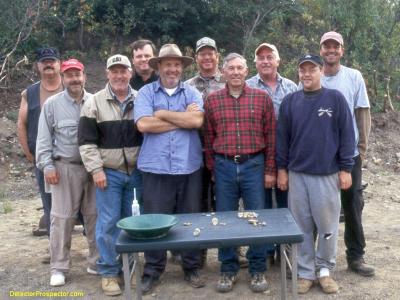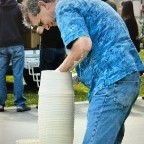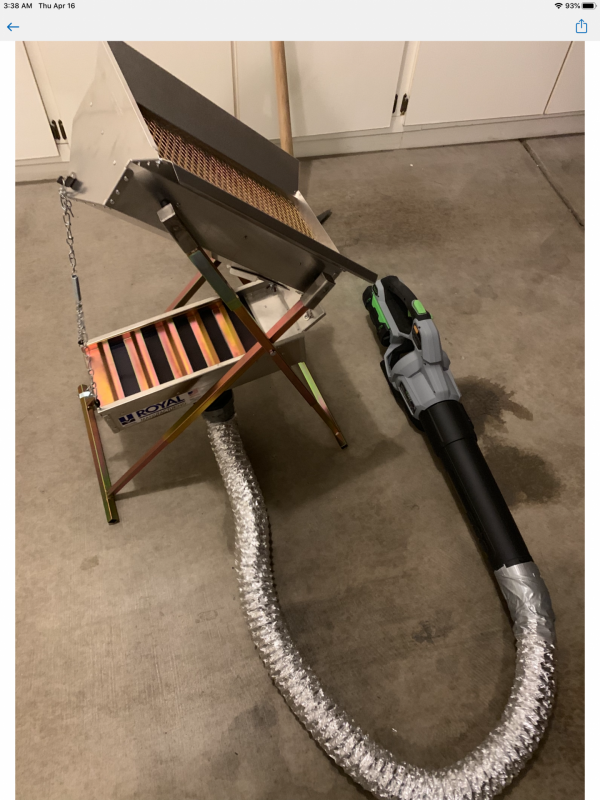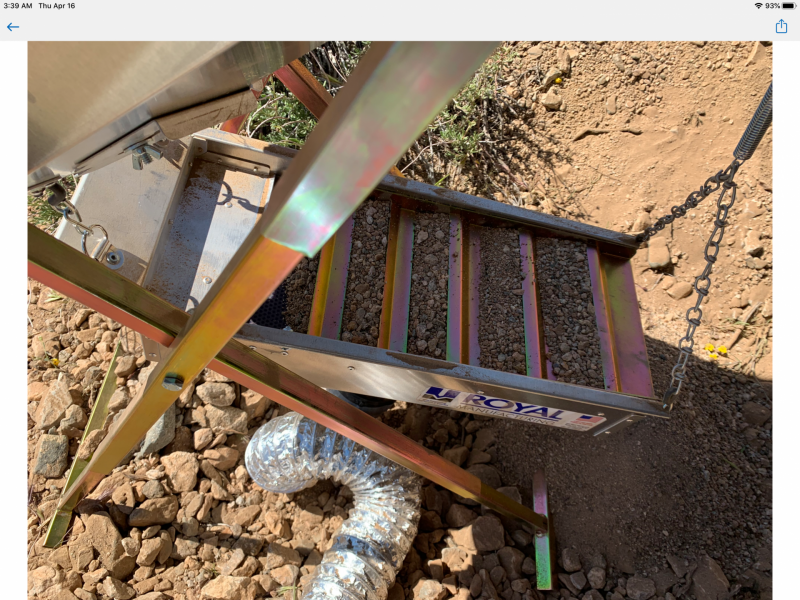Leaderboard
Popular Content
Showing content with the highest reputation on 04/20/2020 in all areas
-
Just me and Heidi. Found a bunch of cartridges, Six .30 Remington in one small area. (obviously a lousy shot...LOL) One .38 Special...all modern stuff. Then a 40-60 Winchester (black powder) unfired, with bullet intact in case, but the case was broken in two. Primer is not dented.; a 38-56 Winchester (black powder); a .44WCF; Two .45 Colts, but one has no headstamp. An unfired 25-20 by UMC; A flattened bullet, and the best find...some sort of medallion with U S on the front. The front is bronze, and the back is lead about 1/8" thick. If anybody knows anything about this item, I'd really appreciate some help. I used the DFX, Settings were "Coins & Jewelry", Best Data, with the 6 x 10 DD coil. It smoothly ignored all the iron.12 points
-
Well, I have about fifteen hours in with the Equinox 800. This is the entirety of my metal detecting experience. All my detecting so far has been in the yard, alley, and parking strip of an 1890 Queen Anne style house in an older neighborhood near the downtown core of Helena, MT. I’m having a blast learning to detect, while trying to unravel the idiosyncrasies of the Nox. I’ve found some cool stuff, the pinnacle of which, so far, is a 1917 D Merc dime, in reasonable condition. (Pics are included) Needless to say I am hopelessly hooked. But… I have questions. Lord do I have questions. 🤣 So I’ve been perusing the forums to try to learn as much as I can from previous questions here, and I also picked up Andy Sabisch’s book, which has helped clarify several points. Following much of the advice given here and elsewhere, I’ve been sticking to the stock settings in PARK 1, and FIELD 1, though I have also played with one of the programs for coin shooting in Andy’s book. (That’s the settings I found the Merc with) So my first two questions: 1. What is the detector telling me when the target signal is erratic? ie. The signal bounces from 21 to 29 to 18 to 39 etc. with the depth indicator also jumping. So far when I’ve dug targets exhibiting this behavior, they’ve usually turned out to be some heavily rusted piece of metal - nail, chunk of iron, etc. What am I missing? 2. What is the detector telling me when I get a strong, high VDI number when swinging one direction, but nothing coming back the other direction, or when swinging 90 degrees to the original swing, the target disappears, but reappears when swinging the original direction. Thanks for any insight you can provide. I know the Nox is pretty sophisticated, and I am inexperienced. I understand I need way more time on it to begin to not only figure out the machine, but also the mechanics of detecting in general! Here’s some of the stuff I’ve found so far:7 points
-
Did a small video yesterday of the effects of Audio Smoothing on an un-dug 1.5 gram target. This signal was a pretty obvious sound and was responding well in all Audio Smoothing modes, on edge of detection signals the reduction in audio information would be more profound. When listening to the file listen to the threshold volume as a guide to the effect Audio Smoothing has on the audio of the detector. Audio Smoothing also reduces the ‘Lead IN’ and ‘Tail OUT’ as the target has to reach a certain point to break through the filter which makes the target signal sound steppy, basically coming from nothing into the point where the target breaks through the restriction. Although it kind of sounds less cluttered and nicer to listen to (Decoupled from reality and less fatiguing) the risk is losing information on the edge of detection responses that don’t even pull you up. This signal was initially extremely faint because of leaf litter, but bounced pretty rapidly once I scraped back the loose surface layer. Pic of the 1.5 gram piece and the haul I got during yesterday’s session I’d like to dedicate this video to the memory of my good friend Fred Mason.7 points
-
We were looking for stage-robbery loot along a stage road that was also an emigrant route. The desert road mostly follows the stage road, but here and there, the emigrant wagons cut a really deep gouge into the soil, and the desert road deviates to avoid those spots. We don't generally hunt the road, as there's too much modern junk, like .22 shells, but yesterday we did hunt the deep sections of the old route, and found a bunch of interesting items. I found an old pocketknife, with only one sideplate, but the plate was mother-of-pearl, which is pretty rare. I also found an unfired .38 S&W round, and a .38 case with no headstamp. Also, the business half of an old hatchet. But the best was the last thing I found....my first Barber dime...a 1902 in excellent condition once I cleaned off the accumulated crud. The places Dave and I hunt, coins are really rare. We also located the encampment location where they spent the night. Lots and lots of trash. We'll be getting to that spot in the future. They couldn't make the spring on the Butte in one day, so stopped at roughly the same place as each wagon train went through. Dave found a pile of stuff, too, but no coins. His finds included a nice obsidian arrowhead, which he left where he found it, of course. He also found a really old spoon, that had broken, and had been repaired by wrapping wire around the neck of the handle. The crushed cartridge is a .44 of fame and legend...LOL I imagine that cartridge with no headstamp is also really old. I was using the TDI SL, and the SP 350 8 x 14 coil. I was running in ALL, but only digging the high conductor signals mostly. Digging low conductor signals results in wasted time...just too much small iron junk. Jim5 points
-
Well, this hunt pre-dates the problems I had with the latest update, which is covered in another thread. I went to a local property that had been farmed for over 100 years. I used Park mode over a well grassed lawn opposite where the original farm house was built. The day was extremely hot, in excess of 40 Celsius and the humidity was close to 100%. Oppressive. 3 hours later and I had detected 15 pre-decimal coins. A terrific hunt by anyone’s standards. I ended up with what we call a full House. (A complete set of each coin issued during pre-decimal times.) In fact, I got equal to two of them. An added bonus was that one of the florins was a commemorative issue. The down side was that, subsequently, a neighbour of the farmer learned of my success and managed to convince the landowner to let him detect the property, trampling all over my permission. They’re out there folks. I was so impressed with the Simplex that I contacted Nokta and told them of my experience with the machine. They asked me to send a short story and photos so they could put it on their website. I did, and they did. More than that, the story and a photo was put up on Instagram and in a full page advertisement in an Aussie treasure magazine. A lot more than I signed up for. I don’t blame them really but felt I had been a little (Lot?) used. Yeah, I know, I’m sticking my head up here, too. Anyway, I have to say I am impressed that such a low cost machine can perform so well. I am impatiently waiting for the current pandemic to subside so I can get out and see just how well the latest update enhances the machine. It’s just a pity that I won’t be able to run over my original site as a comparison.5 points
-
I’ve been out detecting most days trying to keep the wolves from the door (extremely restricted at the moment thanks to lock downs), nothing much to speak of other than it adds up at the end of the week. 😎 Yesterday was a bit more exciting thanks to a couple of deeper bigger pieces, with the high gold price the days take made up the averages for the week. JP Bigger bit weighed just shy of 3 grams, it’s incredible the depth these GPZ’s can achieve.5 points
-
When circumstance allow, I like to go prospecting in Victoria's 'Golden Triangle', one of Australia's nugget hot spots. I use my beach machines, a Tdi Pro and a Tdi Sl Limited Edition. The Pro can be used for prospecting without any real issues, the Tdi Sl is more challenging in this environment. I'm going to focus on my experiences in hot ground, infested with ironstone, hot rocks and heavy mineralization. Not going to focus on depth, power or anything other than what it takes to get the machine to operate smoothly with the correct ground balance. The Pro machine has a hugh advantage, simply by vitue of that course and fine ground balance adjustments but this post is mostly about the Tdi SL. The single turn ground balance on the SL is a pain, it takes a bit of time to get it just right. When the ground is hot the SL requires me to use a smaller coil, mono being the best. Mono coils in my experience are quieter, more stable and much easier to ground balance. Larger folded mono coils, duel field coils and the newer and hotter spiral wound coils all suffer when the ground is very hot, they are noisy and difficult to ground balance with a Tdi Sl. The Tdi Sl with the stock 12 x 7 Miner John folded mono can be balanced but it will transmit more ground noise and be more difficult to ground balance when compared to using a smaller mono coil. Forgive me but I'm going to repeat myself a few times in this post. The smaller the coil the quieter the Tdi Sl will be and easier to ground balance, the reduced 'foot print' helps a lot. The very small 6 x 4 mini Jimmy coil is amazing in its ability to run smoothly and easily ground balance, but is too small to be practical most of the time. In comparison I can use larger mono coils on the Tdi Pro without issue, it has superior ground balancing ability on the goldfields. A Tdi Pro mounted with a 8x6 mono 'Sadie' is my standard setup. The Detech 15 x 10 or Digger 14 x 8 also see some use as does the new to me Detech 8 inch mono when using the Pro. So whilst the Tdi Sl likes the smaller mono coils on the goldfields the larger coils are not an option. Yes the ultimate Tdi Sl setup is a small mono coil and an upgraded 16v battery pack for prospecting. Super light weight and beautifully balanced, respectable performance and versatile. Fun to use for all, kids and older family enjoy the light weight and balance. Allow me to deviate for a moment. Tie me to an ants nest and smother me in honey for stating the obvious. Serious prospectors are better served by more specialised Minelab machines... they are superb. For me versatility is key at the moment and I feel better served by my White's Tdi Pro on the beach, that stealthy little Tdi Sl 'urban PI' is also a pleasure to use. When I invest in an expensive 4x4 and trailer some time in the future, then I'll make room for the more specialised gold machine. Hopefully by then Minelab with have a light weight and well balanced SDC type PI in a Tdi Sl style body. Maybe White's will surprise us all. Fisher is coming to the party also. I need PI peformance and light weight, good balance and sane pricing.. more options arriving as time goes on. Again my one piece of advice to anyone wanting to prospect using a Tdi SL in 'hot' ground, particularly in Australia, is this.. Use a small mono coil. Small duelfield coils like the older Jimmy, 7.5 duelfield, Miner John 7x5 folded mono or 6 inch folded mono coils, are all OK most of the time.. The Razorback 10 x 6 mono is great, the Coiltek Tdi series 6 inch mono is great, The Sadie is great. Keep it small and stick with mono and you should do well in all types of ground. The larger coils work well with the Tdi Sl in moderate soils and the beach. But when the ground goes bad it does pay to swap out for a small mono. Again this is my experience in hot Australian ground. Hot is hot and I suspect many international Tdi Sl users have the same experience in difficult ground. Not looking to pick any fights but this is my experience with the Tdi Sl. Go small, go mono and boost the battery pack. All the best.4 points
-
I did a friend who is a small metal detector dealer a good deed last week (at least for him) by buying a used Makro Kruzer 14kHz detector from him so he could at least make a sale from his home business. I have always liked Nokta Makro products and I had a Multi Kruzer previously and really liked it but the Equinox came along...........and so, I wanted to give the Kruzer another try. I already have a Racer 2 and really like a lot about it, especially its threshold based all metal mode, even though it suffers from the same issues as every other single frequency detector I have ever tried in the moderate to high mineralization in my area which is severe up averaging on what seems to me anyway to be shallow targets 3" to 5" inches deep. I hoped against hope that the Kruzer really was going to be somehow better than the Racer 2. Actually it is worse. I should have learned this lesson after trying dozens of otherwise great detectors with exactly the same results. So, I have tried a zillion settings combinations with so many detectors!!!! Don't feel bad Nokta Makro, you are definitely not alone meaning I get similar results with XP, FTP, Whites, Garrett, single frequency Minelab and Tesoro products. So that is just about everybody! I was hoping I was doing something really stupid. I am perfectly capable of that......... So here is a question I asked on another forum about the discrimination function built into the Kruzer and Anfibio. In my Kruzer manual it says...."Note: DISC. setting works inversely proportional to depth up to level 15 in all modes. In other words, as the DISC. is increased up to 15, stability will increase but depth will be reduced and vice versa. Above 15 though, both depth and noise will increase"I hunt in areas with lots of magnetite iron particles and high mineralization. I usually set my Kruzer discrimination level on at least 4 just to tone down the chatter and keep it from hitting every microscopic iron particle. It will really sort of get quiet at 10. According to the quote from the manual, am I losing a lot of depth by setting it at 10 opposed to setting it at 0 or default 3? Also, one drawback to using the Kruzer in higher mineralization (the mineralization graph is maxed out or one level away most of the time) is that the numerical target IDs are all over the place even on 3" to 5" good coin sized targets. So am I understanding that the stability mentioned in that quote refers to target ID stability? Would running a discrimination level from 10 to 15 along with raising the ISAT level a bit make coin and jewelry targets down to 6" deep have better target ID? The answer to my question at least from my standpoint is that "it ain't happening" and nothing I have tried including all of the things in the manual don't help. Just for fun, instead of driving myself crazy doing tests in my test garden (the results unfortunately were painfully the same) I took the Kruzer to a local park and put my Vanquish 440 in my backpack. I did a little target comparison on wild targets. I was using the Kruzer in 4 tone mode with gain on 80, disc. on 7, ISAT on 0, Iron Volume on 2, Iron Tone Break at 10. I also had 3 tone set up in a similar way. I ran across a target that jumped around a lot between 70 to 84 on the Kruzer and pinpointed it at 4" using both modes. It sounded pretty good and I figured it would be a beaver tail, corroded US zinc penny, a copper penny or even better a clad dime. I got out my Vanquish, fired it up and left it in absolutely stock Jewelry mode with the gain at about 3/4th. The Vanquish read 12-13, which is a low conductor US nickel, pull tab, can slaw or something gold if no iron is present. I checked the target for iron (none) and dug it. The target was a 3" deep US nickel. This happened over and over whether the target was a low or mid conductor. Some complain about the Nox and Vanquish iron falsing. I got a low 90s signal on a shallow coin sized object on the Kruzer that was continuous as I circled the target. I hoped for a US quarter or silver object. No hint of iron at all on the Kruzer even at the edge of the coil. I grabbed the Vanquish and in Jewelry mode got a broken signal that came in between 18 and 25 with an occasional 38. Those jumpy numbers are usually a dead give away for an iron target on the Vanquish and Nox if the audio is crackly and drops out. I knew what the target was but dug it anyway. Rusty crown bottle cap at 4". At least I know when there is iron in or around the target when I'm using the Equinox or Vanquish. I like Minelab detectors a lot. I would also love to be able to use and not waste my time and money on some beautiful detectors by other manufacturers. I guess I just need to move somewhere else. thanks for reading and for any ideas you might have.Jeff4 points
-
You have to get up early to get the scoop first. Dilek just posted early this morning regarding the update. https://www.facebook.com/noktadetectors/ There will most likely be another update, using suggestions given by current Simplex users with current update. Some complaints by those who want to revert back a version or two. Not recommended. Also the new accessory coils will not work with any Simplex that hasn't been updated to the current version. Guess this is why the accessory coils haven't been made available yet. Who knows how far this Simplex project is going,on its way to being the perfect product? For the price this detector is getting better and better.4 points
-
In theory the TDI was made for mono coils and that's why Eric Foster and White's stuck with mono or modified mono. A DD may help in the worst ground but I have seen little to nothing ever said about DD coils being good for the machine. That's a pretty big clue as people will try anything. I know they will function but that's about it. Refer to the link GB posted above and you will see the focus is on mono.4 points
-
I had Shot this video a month or so ago and finally got around to uploading it. I had been raining on and off for a few weeks and so the digging was easy 🙂4 points
-
Hi GB_Amateur The dirt where I detect is one bar from the highest level on the Makro Kruzer, F75, F19, Deus is 2/3 to 3/4 full and so is my ORX. It is all from the Denver Formation whether it is topsoil, hauled in or right from the formation itself. Anywhere you dig in West Denver that is not near the South Platte or Clear Creek you will hit dirt from this formation since it is between 600 and 1500 feet thick and consists of sandstone, coal shale, monzonite, basalt, tuft and volcanic ash from nearby volcanos and from even the Yellowstone Caldera from what I hear. In most places the undisturbed parts of the formation are from surface to 15ft below the top soil. If you are at a park like Rocky Mountain Lake Park, you are digging in sediments from Clear Creek. On the east side of Denver the sediments are a little different. Cheeseman Park used to be one of the city cemeteries. Mostly it was for poor people or unknowns. I have no idea what kind of dirt they hauled in to cover all of that up. thanks, Jeff3 points
-
Very sad news, my condolences to Fred's friends and family. I wish that I had been blessed with the opportunity to meet him, I will do as suggested and have a shot of tequila tonight in his memory. RIP Fred.3 points
-
Unfortunately I can't answer your questions, but your post has triggered some questions from me which I'm pretty sure you can answer. I think you've answered them previously, but maybe repeating them here would lead others to have an idea or at least tell them why their experiences are different. 1) What is the Fe3O4 reading on the F75 and Gold Bug (family) typically for these soils? 2) My detecting in the Denver area parks has not been nearly as bad as you describe. I'm thinking the parks I've hunted have had their dirt hauled in from somewhere else, or I'm just lucky in having hunted in the parts of Denver that have mild(er) soils. (I seem to recall you saying that the mineralization there varies a lot.) A couple I recall the names of are Rocky Mountain Lake Park at 46th & Lowell and Cheesman Park. This afternoon I'm going to measure the Fe3O4 in my back yard test area with both the 5" and 7"x11" coils of both the F75 and Gold Bug Pro. Ironically, in my test garden the TID of high conductor coins decreases with depth for the F75 with larger coils. (I haven't tested much with the 5" coil.)3 points
-
Now you know why I thought Multi-IQ was a game changer and why I cleaned house once I saw it in action. It simply works better in my ground, where I get a nice dime reading and dig an aluminum beaver tail when I use a single frequency machine. The best solution it would seem to me would be to stop thinking single frequency is the answer in your ground when it would seem pretty clear it is not. In some ground single frequency really is obsolete when it comes to discrimination. If you want something better, wait for the next version of Multi-IQ or maybe the NokMak Multi, whenever it appears. Or maybe even a Tarsacci. Single frequency by technological standards is ancient technology, so last century. Just sayin. The best use for single frequency in bad ground is for all metal nugget detecting, no discrimination, or at most ferrous/non-ferrous disc. Accurate non-ferrous target id in bad ground - not so much.3 points
-
That Super Pulse 220 mono coil uses the time proven 9.5 housing so common on earlier White's. So scuff plates are easy to replace and coil hardware is all White's. Performance on the Tdi Sl is good, particularly with the higher voltage battery pack. A great all rounder. The small 6 x 4 Tdi coil is super easy to ground balance and super quiet on the hottest ground, but is so small I rarely use it. If you can find one, pretty rare are the White's 7.5 mono coils made for OZ, good for the goldfields but maybe a bit small for the beach? Another option would be the Razorback 10 x 6 mono, super light weight, good performance and decent coverage. Not sure how it would work out hardwired on a Beachhunter, but in hot ground it would be easier to ground balance and operates a bit quieter and smoother.3 points
-
Tony the mono coils work very well in hot ground on the Tdi machines. Much better than the duel field coils, this is obvious when it comes to ground balancing the machine and ground noise. As per earlier posts no surprise you are having difficulty with the larger 12 inch duel field coil. In my experience if you were to hard wird a coil on the Tdi Beachunter, my choice would be limited to mono coils. Second I would not go under eight inches or over ten. Thus my advice is limited to coils I have used on both the Tdi Pro and Tdi Sl. First choice would be a Whites coil, the Super Pulse 220. It is 9.5 inches and a mono. Ground balances and performs well. Hard wired it would be a great do all coil. Much better on small targets than the larger 12 inch White's mono. Pity Whites didn't offer this size coil as an option, earlier White's beach PI machines had this size prior to the introduction of the 12 inch duel field coils. Second pick would be the Detech 8 inch mono, very sensitive, high performing and water proof. Solid construction and highly recommended. Suspect both coils would have 'flotation' issues etc. Both are my 'ideal' size and do the job as all rounders. I suspect the White's coil would be easy to obtain in the USA and the Detech simpler to find in Australia. If it was me, I'd put the White's Super Pulse 220 on the Beachunter, hard wired it would be my ideal. A White's coil on a White's machine. You could always swap it back if it didn't work out, so don't cut off too much cable etc whatever you do.. Should mention this coil works well on the beach and the goldfields. I've tested it in Victoria's goldfields, no issues with ground balance, quiet operation, smooth and stable performance. Much quieter and easier to use than any duel field or folded mono coil. All the best.3 points
-
I would like to thank everyone of you who read this post and especially the ones that left comments. For me it has been like attending a celebration of life for a dear friend. I never get up in front of a crowd and say the things that I would like to share about good people and I know that I am not alone. I am going to encourage Freddy's family to access this forum to read all of the nice things that people have shared. I am adding a picture of our last hunt together in Northern Nevada last October. Left to right Jonni and Fred, Mike G. and Michelle, My wife Heather, myself and Louise. (she goes by Lucile on the forum}3 points
-
I have to admit you have a tiger by the tail. New to the Equinox and new to metal detecting. Where do I start. First of all stay in one of the standard modes. Way to early to be messing around with settings other than sensitivity. Why did you pick the 800 as your first detector as a total newbie? They have a long and steep learning curves for a newbie. The Vanquish 540 would have been a better choice. One of the main problems is the 800 is a hot, hot detector. Meaning it sees every little spec of metal in the ground and has a tendency of making small pieces sound big and big pieces of junk like a squashed tin can sound like a coin. What you are seeing with jumpy TID's is the Nox reporting a lot of stuff under each coil swing. The ground in most places if full of junk. Just turn on the horeshoe start sweeping. In a lot of places you here constant hits. Buy Clive Clylnick's three books on the Equinox and study there carefully and practice what he writes about. Probably the best written guides for the Equinox by any author. Literally you have way too much to learn to put in a post. I got my nox 800 in April 2018 and took me more than a year to learn and I have been metal detecting since 1987.2 points
-
My wallet stays in my pocket while detecting. In almost 60 years of having a wallet, I've yet to lose it. As for keys, I carry two sets in my pockets and one elsewhere that is accessible. In the water, wallet stays dry in vehicle most of the time. And I always place a visibly empty box of cartridges on the dash.2 points
-
The purpose and context of my post was to inject some reality into the OP postulating that Nokta was incrementally increasing the Simplex capability into some "perfect product" (his words, not mine) and my only comparison was against a similarly priced entry level competitor that performed better. I don't have any of the other Nokta detectors mentioned and did not plan to show it perform against the likes of a Deus or Equinox, which is neither relevant nor appropriate. In other words, I know your question is rhetorical, Steve, but I assure you that I am not falling into the common trap we repeatedly see on You Tube of someone trying to compare a Yugo to a Tesla. Also, there is nothing special about my test garden, I mainly use it to tune my ears to GPX audio prior to a relic hunt and test my GPX to various relatively shallow relic targets with different coil and soil timing settings combinations as a functional equipment check before hauling out to a site. It is not meant to test the limits of detection of even a VLF detector, by any means. That is why I was surprised by the Simplex performance.2 points
-
I have a MultiKruzer and played around with the disc settings a bunch with my deeper test targets due to the commentary in the manual about depth/noise in regards to the disc setting and was never able to discern any difference in depth due to disc settings. Granted that our dirt in Florida is as mild as it gets for the most part. Also I rarely get use any discrimination with tone ID machines and the MultiKruzer is definitely better at unmasking(IMO) when you can hear the iron too. That being said I rarely use it anymore due to the “sizzly” digital audio being extremely fatiguing.2 points
-
If the Simplex at $259 detected as well as any of the more expensive Nok/Mak detectors, what do you suppose might happen to sales of those more expensive models?2 points
-
Thanks Chase! No chance of it being hit with a plow blade in that location. Not much chance of shovel either. I'm wondering if maybe a hatchet when it was still on the box? It was folded over right on the cut line. After looking at it again, it looks like the cut was made from the back. So much for it being hit while on the box...LOL The lead on the back has tapered edges at the cut line. Obviously a sharp object, with considerable force, to cut through both metals. I looked all over that portion of the trail, but did not go out into the sagebrush on either side. I'll have to get to that....good suggestion! It was NOT a good place for the Indians to ambush a party....No cover closeby, and fairly flat. Jim2 points
-
Looks like a Civil War era or Indian War era cartridge box plate. The cartridges used were typically paper cartridges with lead minie ball projectiles. However, US Cavalry did use a variety of carbine rifles that used large caliber metallic cartridges and carbine minie balls. They were typically .52 to .54 caliber. Look for fired or dropped large caliber minie balls in the area where you found that box plate. It looks like it was hit with a plow blade or shovel while it was in the ground.2 points
-
In general there are only two ways to increase target id stability, ignoring the EMI issue. That is a wild card, especially silent EMI that only exhibits when a target is detected. Be sure and have a perfect ground balance, and reduce sensitivity. Increasing discrimination can adversely affect sensitivity, so after 15 NokMak is applying secondary gain in an attempt to offset this. So if the machine gets unstable above 15 oddly enough it is even more important to reduce the gain. Smaller coils can help. The problem is target stability is achieved by reduced sensitivity which people interpret as meaning less depth, so I find that nine times out of ten getting target stability gets tossed out the door in the desire for more depth. It’s actually something the operator has control over, but it is a trade off. In general “hot” machines are less stable.2 points
-
Hi Steve and kac, Just for anyone else reading this, the Makro Kruzer only comes in one single frequency model which is 14 kHz. The Anfibio does have a 14 and 19 kHz single frequency model. I started this topic because of the somewhat cryptic quote from the manual about discrimination being inversely proportional in part of its range. I was hoping someone would help me understand that better and see if there was a way to stabilize target ID more. Using zero discrimination where I hunt is not an option unless I run the gain down between 20 and 30 in any mode except beach which has a default of 15 for good reasons. Otherwise, the carpet of magnetite and broadband EMI will be impossible to penetrate in order to hear an actual target. Definitely not bashing any detectors here. The Makro Kruzer is a wonderful single frequency detector and all the other brands I mentioned make excellent single frequency detectors for most places......... Jeff2 points
-
That's quite a haul for your first 15 hours! You have some good hunting grounds. If that's a 1933-D Lincoln, it's a pretty scarce find and particularly for one of your first ever coin finds. (I can't read the leftmost Lincoln. Mind relaying the date and mintmark?) There are a lot of things that cause the Equinox TID to jump around. (Coil control is just one, but something you'll eliminate with experience.) You are doing the right thing to dig them all. The best way to figure out what it means is to keep doing that and cataloging the results in your brain. Eventually you'll get an idea of which are likely trash and which are likely good. Just remember 'likely' is the best you or anyone can ever do. There are an uncountable number of target sizes, shapes, chemical configurations, and that's just for a single object. When multiple objects are under the coil you can get another spectrum of responses. Metal detecting is a tradeoff of how much junk you're willing to dig vs. how many good targets you're willing to pass over.2 points
-
Yep, cartridge box plate. Chase will likely tell more about it when he reads this thread. Too bad about the condition, but still an unusual and difficult find. Well done!2 points
-
I have some beaches in my area where the EMI seems to come from the lighting installation at the promenade. Switching to single frq. helps in those spots.2 points
-
Phrunt😷, its an Iron Bark so can be considered a HARD WOOD😜, there was never any fear of it going all soft and falling over!!🤕2 points
-
2 points
-
I like the GMX/24k. I got the White's GMX which is a waterproof 24k for lake hunting for jewelry. I've only tested it outside so far using the 6" concentric coil which is 6.5". This detector is completely silent even with sensitivity max. No chatter at all. The iron disc is completely adjustable 1 point at time. At 19 it disc's out a nail one way and gets a hit the other way. I wanted the disc set as low as I could. The vco mode is the deepest and most sensitive mode. Even with disc at 19 I can get a hit on the white gold earring laying on the ground. It does have to be close, approx. 1/4" or less to the coil, but it hits it both ways. I buried a 0.89 gram 10k gold ring at 9" and it got a nice hit all around. Also hits my 10" test dime. I sold the 4x6 coil. The 6.5 concentric was all I wanted. Might get the 6x10 sometime. It is in the XP Sport housing. Even though it weights 4 lbs it feels ok with the small coil. I wish White's had spent some time designing it light weight but it is still comfortable enough to use. I like the display. I like the balance of GMX better than the Gold Kruzer. I hip mount the Gold Kruzer in the water because the balance of it hurts my forearm in a short time. Could probably get used to it though. I like the display on the GMX. At the top there is a bar that shows where the target is from iron thru silver range which is convenient. It is going to be a great lake hunter. Now it's making me think about getting another MX Sport. White's has nice products.2 points
-
That button was modern. Went back out on same field and found another large cent, modern 925 Irish Cladah ring, beat up IH, 44 Merc dime, 54 silver dime, small silver hair barret and over $8.50 in clad. The large cent was very shallow and noticed there are sprinkler heads in the area. Taking a wild guess but think the old stuff got turned up when they were digging trenches for the water lines. If that's the case I'll go back over and look for just the deep faint targets.2 points
-
Yes mate. Being a computer troglodyte, I was very cautious about following the instructions in the update panel. I initially had problems accessing the actual update but I didn’t connect, or turn on, the detector until I was supposed to. Apart from the scare I got when the Simplex started its catatonic state, the most confusing thing is that I don’t know why the problem occurred. The update seemed to function correctly until the very last minute, including the message that the update was successful. As they say in the classics - “WTF?” All that aside, I have to say how impressed I am with the scope of changes made. I’m yet to run it over the ground to see how it all goes but, for such an inexpensive machine, Nokta have impressed me with the amount of grunt under the bonnet and the effort they put into producing and improving a machine that rivals far more expensive units. Kudos deserved.2 points
-
The main issue is the dual field. A step in the right direction would be the 12" Aussie Mono and for even worse ground the 7.5" Aussie Mono. These coils were made originally specifically for the TDI Pro Oz version. The TDIBH is hardwired so not a plug and play thing but can be done. If I was to get another TDI the 7.5" Aussie Mono would be high on my wish list. https://www.google.com/search?q=white's+tdi+aussie+mono+coil2 points
-
Fred had many lessons to teach. One of them I learned by taking a trip to Tucson for an outing. I had decided I was going to go through Yuma to a place called Potholes where Fred had been in the past. I asked him where to hunt and he gave me the 'lay of the land' so to speak and told me to hunt under the wires. Well, I'm not that great with directions but I did find the power lines and I hunted some likely spots and I found a nice nugget of a couple of grams. There was also a few more smaller ones and interesting trash. After the trip was over I called Fred to thank him for the tips on the place and I told him where I had found the nuggets. (This is the information you get back if you share.) Fred listened and thought about it a little while and he told me that I had gone to the 'wrong' wires! haha We had a chuckle about it and he wanted to know where I parked and where I found them. About 3 weeks later there was a posting on the forum of some nuggets Fred had found. (More than I had found) He told everyone he got out of his truck, geared up and found them within 30 feet of the truck. (He didn't tell everyone our location.) That is where I had parked! haha As it turns out Fred found lots of nuggets where you park and some of us have taken advantage of his lesson over the years. I know I hunt roads and parking lots more now because of Fred.2 points
-
Fred was the oil upon the waters of my oft times turbulent sea, when my words were too passionate he had a way of chastising without my feeling chastised with his easy going unassuming manner, “his soft way of delivering a strong answer”.😏 A true gentleman and all round decent human being, the knowledge of his passing has come as a shock.😔 I first met Fred in Arizona at Rich Hill with Chris Gholson at one of the AZO gatherings, we were camped up at decision corner and he invited us to his motor home for some of his famous ‘Chile Verde”. I had no idea what it was, so for this Aussie country bumpkin it was an enjoyable learning curve. Since then we’ve often passed messages too and fro as well as forum chat. From memory the last time I saw Fred was in WA when he was on a gold tour up in the Kimberley North West Australia, I heard the group were in the vicinity of where I was working so I went over to say hello and ended up getting invited back to the camp that night for dinner. Fred I will miss our interactions with each other, without your wise words and calm ways the world is now a much poorer place.😪2 points
-
2 points
-
The new Fisher Impulse AQ is doing something new with pulse induction discrimination. I think I have a pretty good idea of what the engineers are up to and so want to pass on my thoughts in case it will help people have a better idea of what to expect. I have posted numerous articles in the past about coin detecting with ground balancing PI detectors. GBPI detectors split targets into two classes depending on the ground balance setting. The two target classes exhibit by different tones. All Minelab PI detectors do this, as do the Garrett Infinium and ATX, plus the White's TDI series based on the Eric Foster Goldscan. White's on the TDI labeled these as low conductors and high conductors but that is not actually accurate. They are items with a low time constant and items with a high time constant as measured on a pulse induction metal detector. For more on signal decay and time constants see the excellent primer by Reg Sniff Understanding the PI Metal Detector. If you could measure the time constant of the various targets and line them up you would see size has a lot to do with it, small items versus large items regardless of composition. White's TDI "Target Conductivity" switch (notice ground balance on required) I caught on to this fast with the Garrett Infinium in 2004 and Minelab GP 3500 in 2005 and when the time came it was I who suggested the tone switch be incorporated into the White's TDI to allow the user to choose between one of the two classes of targets. Plus the TDI allowed the operator to directly set the ground balance, creating a crude discrimination system for savvy operators. It is actually possible to coin detect with a TDI and dig almost no trash, but you lose its PI depth advantage by setting the machine that way. I preferred using the tones with full depth settings myself with excellent results. The two target classes vary depending on the exact ground balance setting, but generally one one hand you have low conductors and small ferrous targets, and on the other hand coins and large ferrous targets. This means if looking for small gold you dug all manner of small trash including small ferrous trash. Coins were better but you would still dig large nails and other large ferrous items. The TDI allowed a person to advance the ground balance to where most ferrous trash could be eliminated while still getting the coins, but the setting was so close to the coin range to do this that depth suffered as a result, and so was no better than a decent VLF. It's a long read but a lot can be learned by reading the following three links. Coin Detecting with the Garrett Infinium Beach Detecting with the Minelab GP 3500 Coin Detecting with the White's TDI Some Commentary On White's TDI Tuning & Discrimination It can be seen that as far back as 2005 I was predicting that high power PI detectors would find widespread use with beach hunters and relic hunters in particular. That prediction did later come true at Culpepper and other locations. It was obvious to me that this crude discrimination offered more room for improvement. I even emailed Carl Moreland at one time and made mention of the concept of using two ground balance controls to delimit another class of targets beyond the two created with a single ground balance point. But really it is not ground balance, it is just a setting that measures a certain time constant. And that folks, is basically what the Fisher Impulse is doing. It is using at least two dividing points to separate items into three classes, lowest time constant, middle (gold ring) range, and highest time constant The Impulse is eliminating the items with the shortest time constant and the longest time constant and focusing on the mid-range. This eliminates tiny trash and tiny gold, and large ferrous stuff and most coins. What is left is the sweet spot in the middle where gold rings occur plus a yet to be determined range of trash targets. There will be some, that is inevitable, but the vast majority of trash should be eliminated with this approach. This picture shows the result of using the Garret Infinium and separating the short time constant targets from high time constant targets in tot lots. Low constants (nickels and zinc penny plus trash) on left and high constants (copper pennies, dimes, quarters) on right. Notice very little trash with the coins if you dug that class only. But that is deceptive due to the location, which lacked any nails. Garrett Infinium targets separated by tone So take a look at this result from a park, this time only the long/high time constant targets with the TDI... coins and large nails. White's TDI low tone / high time constant targets OK, so let's combine the two to get a clearer picture.... Left of red line low time constant versus right side high time constant targets To reiterate, having only one point of separation presents issues. You get coins but you also get large nails. And the low time constant area is a mess, just way too much stuff including small ferrous. But in areas with few nails it actually works well for coins. The dividing line does vary with the ground balance setting but is roughly about zinc penny if ground balanced in moderate to high mineral ground. The Impulse AQ is basically blowing off the high end to get rid of the nails, and the high conductor coins also get tossed out. Most jewelry hunters will be fine with that - digging coins in the surf is a waste of my time and effort. The AQ is adding another separating point somewhere in that left hand low time constant area, that eliminates the tiny stuff including I assume most wire type ferrous items and foil. Rings due to the round shape with a hole read better than most of the misc trash in the photo. However, some of those items will read in the ring range so do not expect the AQ to be trash free. Trash that reads close to the nickel range will probably come through, like pencil eraser ends and some tabs that read like nickels. If you think of the AQ as a nickel detector that will probably not be far off the mark. My biggest area of concern is zinc pennies, especially corroded ones. I hate those things but I suspect we will be digging them with the AQ. All the above is just speculation based on everything I have learned using this class of detectors over the last 15 years. I have had no part in the AQ development. That said, I think most of what I am describing will prove to be pretty close to the mark as far as how the discrimination functions on the Impulse AQ. And just a reminder. The Impulse AQ will let you turn off the discrimination to run in pure pulse mode, presumably with no ground balance engaged. It should be at similar to but more powerful than the TDI Pro with ground balance shut off. This will not be good for nugget detecting in most areas as it will light up hot rocks, but for many beach detecting situations should be giving us a detector like the famed Eric Foster Deepstar in a much more ergonomic and affordable package.1 point
-
If this is just general commentary in response to the philosophy of Nokta supporting this detector with frequent updates and cautionary remarks against folks with unrealistic expectations trying to conflate the Simplex into a GPZ or posting disappointment because it doesn't perform like a high end detector, I just want to say, I get it and you don't need to read the rest of this. But if it is in response to what I posted previously, something is perhaps being taken out of context and just want to set the record straight on what I am trying to do. I know it is a common concern that detector nerds/snobs try to take out an entry level detector and try to compare it to something in a completely different performance class and price range. Someone said it is going to be a perfect product, I am having trouble picking up easy targets in a test garden that an entry level Vanquish is detecting. That was my only point. I went to great pains to point out that I had no preconceived notions or bias. Could be operator error, could be a bad setup, could be a bad machine, could be underperforming software. I merely indicated that I am investigating it and trying to do it in a fair manner against other machines in the same capability class. I would like to understand if the issue is fundamentally with the machine, it's delivered software, or whether the issues resolve with the new software release. I know that Simplex is entry level and am trying to be true to that frame of reference in my approach to testing it. If anything, I am biased the other way as I am honestly rooting for it to be a halfway decent performer with great features at its price point especially as Nokta continues to support it with performance updates and new accessories. Will follow this up with hopefully some useful, and perhaps documented, info later this week. The biggest challenge in this effort is figuring out how to properly use the GoPro.1 point
-
Now that is interesting indeed. Since the new Multi machine is going to be in the Simplex housing, I wonder if this is related? It would be easy to design coils for Simplex that would also work on a multifrequency detector. Like the way White’s V3i coils also work on the MXT. Would be a brilliant move if they were thinking in that direction.1 point
-
Personally I think ML did replace the Xcal ... at least for many. Very few water hunters dive... and use a detector. So the obvious update was a quality wader. We asked for a machine we could Change the phones and coils on, we wanted it lighter, faster, able to pick up deeper and smaller gold, cheaper better warranty than the 1 year, fewer repairs or mods needed. We got it at half the price if you did mods and 3X the warranty..... and service improved 1000%. So unless you really dive .... which 95% of beaches don’t I think they gave us what we wanted.... and a bit more with Bluetooth and magnetic charging. If you dive.... especially very deep the Xcal might not have been you choice either.... especially to 200 ft. However.... is it time for them to design a dive ready PI .... yes1 point
-
Rest in Peace as you shall be missed by those of you and your knowledge has touched. Heaven has now received another whose detector is now on virgin ground with lots of finds for you to enjoy. We shall miss you, and we shall remember your words that you have given us. May your family know that we are praying for them during their time of grief.1 point
-
R.I.P. Fred. You greatly helped me get started in all of this. I am forever grateful.1 point
-
Oh my gosh, I'm very sad and shocked to hear that! He just posted on Wednesday!! I knew his health had not been well the last couple years but still.... 😞 Fred and I have been in regular communication, and in fact he was supposed to stop by for a visit this last fall, but got waylaid. I have not seen him since a brief get-together a few years ago. I really knew him more from a visit to my Moore Creek Mine many years ago. My condolences to his wife, family, and friends. He will be missed. https://www.detectorprospector.com/forums/topic/1045-steves-moore-creek-article-in-icmj/ Fred in 2005 at Moore Creek In front left with hat and blue shirt....1 point
-
"INDIAN RIVER SHORES, Fla. – They don't call it the Treasure Coast for nothing. Jonah Martinez, 43, a treasure hunter from Port St. Lucie, was scanning the sand with his metal detector at Turtle Trail Beach Access on Feb. 21 when his device picked up a signal. Buried beneath him was more than three centuries of history: Martinez pulled 22 Spanish silver coins from the surf, each dating back to a shipwreck 305 years ago, he said." https://www.usatoday.com/story/news/nation/2020/02/28/spanish-coins-1715-shipwreck-unearthed-florida-beach/4902578002/1 point
-
Sorry Kac, but the crystalline structure of your rock pretty much rules out a meteorite. I'm with you - it appears to be some sort of a granite. Better luck next time!1 point
-
FedEx showed up at my door with my little Royal Explorer drywasher late Tuesday, the Jeep was loaded to head out to gold basin in the morning so I made a quick trip to Home Depot to pick up a 3 inch air hose to connect my 56v leaf blower to the drywasher. sadly Home Depot’s not really a hardware store any more so it’s hit or miss sometimes finding what you need and I had to settle for a 3” clothes dryer connection for my test, they were also lacking in any suitable adaptor so I was also stuck using the leaf blower nozzle for my reducer for my test while the dryer connection worked it’s less than ideal for regular use. setup was easy and the battery powered leaf blower worked perfectly powering the drywasher, the fan speed was very easy to control and I wound up using a low medium speed similar to the setting in my time test, the leaf blowers controls made subtitle adjustment easy. The battery operated blower is much quieter than a gas blower, no fumes, weighs less and starting and stopping is just a flick of the switch. im having trouble uploading videos to YouTube so for how here’s a couple pictures of the setup. I did email EGO directly to let them know their leaf blower might be desirable For this use and consumers have been requesting a shop vac version hopefully sometime in the future they develop a shop vac/blower version similar to the gas powered vac/blower units in use now.1 point
-
Nice old finds, everything from a horse shoe to the harmonica. Great job.1 point

.thumb.jpg.ac5e8ee36e43bcab745dbc623fcf1874.jpg)



